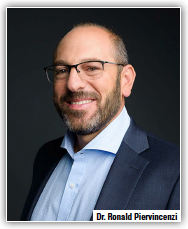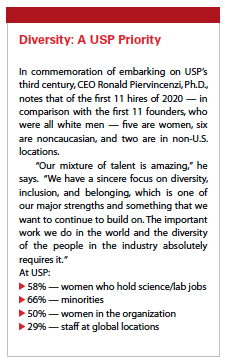USP: 200 Years of Building Trust
 Ronald Piervincenzi, Ph.D., who has served as CEO of the United States Pharmacopeia (USP) since February 2014, discusses the organization’s evolution over the past 200 years and its strategy for the future.
Ronald Piervincenzi, Ph.D., who has served as CEO of the United States Pharmacopeia (USP) since February 2014, discusses the organization’s evolution over the past 200 years and its strategy for the future.
PV: Congratulations on the 200th anniversary of USP. How has the organization evolved over the years?
Piervincenzi: We are all about scale and diversity. The founders were, not surprisingly, 11 middle-aged white men, who came together to set national standards for compounded medicines — the first time this had ever been done. Today, USP has facilities across 12 global sites. More than 2,000 people contribute to our work, of which 1,300 are full-time staff and another 800 are our expert committee members who evaluate every type of medicine, inclusive of dietary supplements, OTCs, biologics and prescription medications, as well as herbals and compounded medicines.
PV: Why has USP been successful for so long?
Piervincenzi: Our longevity is a testament to some good thinking, creativity, agility, and just as important, staying true to the original mission around supporting quality medicine. The theme we continue to explore is trust. In the end, a physician or a pharmacist working with a patient has to trust that the manufacturer and the local regulatory authority, for example the U.S. Food and Drug Administration, has met standards for quality medicine.
We are proud that USP is so trusted; this is a responsibility that also requires us to continue to evolve and to be positioned as a trusted convener where different entities can come together.
We also know that the value of quality, not coincidentally, is underappreciated around the world. Over the last five years, we have changed quite dramatically how we advocate for quality globally. We’ve made some amazing progress on several projects that we’re very excited about. For example, we were able to  prove statistically that poor quality medicine is as problematic as poor adherence in driving up anti-microbial resistance. This finding has been recognized by UN and WHO resolutions. In this context, our goal is to raise the value and importance of quality medicines in parts of the world that we as Americans may never visit, but in the end could have a very serious effect on our own medicine supply.
prove statistically that poor quality medicine is as problematic as poor adherence in driving up anti-microbial resistance. This finding has been recognized by UN and WHO resolutions. In this context, our goal is to raise the value and importance of quality medicines in parts of the world that we as Americans may never visit, but in the end could have a very serious effect on our own medicine supply.
PV: How does USP intersect with other regulatory bodies to oversee the global supply chain?
Piervincenzi: USP’s work has three interfaces. The first interface is with regulatory authorities, and by far the largest is with the U.S. FDA. FDA employees serve on expert committees that set our standards. Increasingly, we are also working with global regulators; more than 50 countries are adopting our public standards.
The second interface, which is our largest cohort, is with industry. More than 600 scientists from over 100 pharmaceutical companies are members of our expert committees. These individuals, who bring their expertise to bear, make a five-year commitment to work on USP public standards to set the bar for what good looks like in the world. Of the 6,000 public standards that we have today, more than 90% were created with the active participation of industry scientists.
Our third dimension, while not quite as large, is with academia and practitioners — the pharmacists, physicians, nurses, and other healthcare providers who are at the end of the chain. These folks are important because USP standards do more than just simply measure, analyze, and set the parameters to test medicines, we also oversee how medicines are packaged, named, distributed, and even administered.
In addition, we have physical standards for analytical laboratories. For example, we shipped physical reference standards to more than 22,000 manufacturing facilities in more than 150 countries. Another marker is the millions of views of our online standards: tens of thousands of institutions and hundreds of thousands of users reference our USP standards every day. When we map the thousands of medicines that are being made across 50 or 60 countries, multiplied by all of the ingredients, the breadth and depth of the system is amazing. This speaks to the importance and value of having a public standard. Our digital USP-NF had more than 16.5 million page views in 2019.
PV: What does the future hold for USP?
Piervincenzi: I commissioned a study to learn about the role USP has played in innovation, in particular, public quality standards. We asked the simple question: do public quality standards help bring about innovation faster? We learned there are two ways in which our standards help increase the pace of change or the adoption of new innovations. The first, and the most obvious way, is that innovation often builds on what’s already in place. Even the most radical new medicines, for example personalized cell therapies, use ingredients at the beginning of the chain that have to be of quality. This involves our standards, which in some cases have been in place for decades.
The other way innovation is supported by public standards is by reducing risk and uncertainty. Having good public quality standards is a basis on which to create and bring forward innovative medicine not just in the United States, but broadly.
And as medicines become more widely available, or in some cases even adopted in the generic marketplace, standards create a common bar for quality that prevents medicines from coming to the market that are substandard or come from parts of the world where there are different rules.(PV)
~~~~~~~~~~~~~~~~~~~~~~~~~
Diversity: A USP Priority
In commemoration of embarking on USP’s third century, CEO Ronald Piervincenzi, Ph.D., notes that of the first 11 hires of 2020 — in comparison with the first 11 founders, who were all white men — five are women, six are noncaucasian, and two are in non-U.S. locations.
“Our mixture of talent is amazing," he says. “We have a sincere focus on diversity, inclusion, and belonging, which is one of our major strengths and something that we want to continue to build on. The important work we do in the world and the diversity of the people in the industry absolutely requires it. “
At USP:
58% — women who hold science/lab jobs
66% — minorities
50% — women in the organization
29% — staff at global locations


















